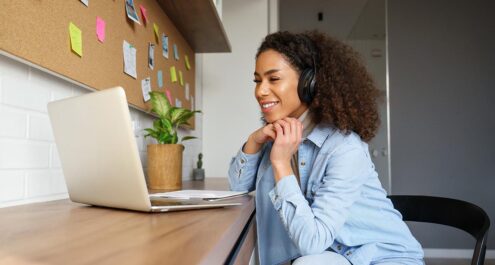Module Introduction
As an educator, what do you want most for your students when they graduate and embark on life?
Do you want them to have a love of learning? Or do you want them to be an active and engaged citizen? Perhaps you are hoping they know what they want to pursue in college or university, or how they want to contribute to the world. Or would you like them to have the skills and tools to create a fulfilling and meaningful life for themselves and to help others to do so, as well?
These “bigger picture” goals we strive towards as educators relate to students’ sense of purpose—an important aspect of student well-being. Indeed, helping your students cultivate a sense of purpose is one of the noblest aspects of teaching.
Spark Interest
Take a moment to listen to a Happiness Break podcast that leads listeners in a meditation about finding purpose by imagining a better world.
Happiness Break: Visualizing Your Purpose, with Dacher [9:02]
Reflection
- How might you lead students—whether young or older—in a similar exercise? How do you think they would respond?
Learning Objectives
In this module, we will explore the role purpose plays in young people’s success in school and well-being both within and beyond the classroom by addressing the following questions:
- What is purpose? Why is it important for young people?
- How does purpose develop in students? When can you start talking about purpose with students?
- How does identity relate to purpose?
- What can educators do to inspire students to explore and find their purpose(s)?
Module Resources
This toolkit includes additional resources, including classroom lessons and practices organized by developmental level, staff meeting activities, videos, podcasts, articles, and professional learning opportunities, as well as supporting materials for group facilitation on the topics of "Purpose for Adults" and “Purpose for Students”.
Individual Exploration
To help support your students’ path towards purpose, we begin by exploring what purpose is, why it is important, and some practical ways you can lay a fertile foundation for purpose development in your classroom. Indeed, research has shown that the support of teachers, mentors, and other adults outside the family is often crucial to young people’s development of purpose, particularly in the early stages.
What Is Purpose?
Watch this short video of purpose expert Dr. Kendall Cotton Bronk defining what purpose means. [7:17]
Reflection
- What is one takeaway you have from this video about purpose? Did anything inspire you to think differently about the role of purpose in education?
Purpose and Young People
In this next video, learn what researchers have discovered about purpose and young people.
Reflection
- What is one reason you might want to help students foster a sense of purpose?
Links from Video
- Exploring Your Personal Values (Middle school) Students sort value statements in order of importance, then reflect on the ones that mean the most to them. (30-45 minutes)
Teaching for Purpose
In this next video, learn about the developmental aspects of teaching for purpose with young children, along with practical strategies to use in the classroom. [16:36]
Reflection
- Reflecting on your current students, can you identify any of their interests or something that suggests a sense of purpose—from what you know of them so far?
- Which of the strategies resonated the most with you? What ideas do you have to put this action more intentionally into practice?
Links from Video
- Positive Teacher-Student Relationships What they look like, why they’re important, and practical strategies for fostering them.
- Building Collaborative Classroom Norms (Middle-high school, but adaptable to all ages) Students co-create norms that foster a welcoming class environment and ensure safe discussions among peers, and develop a personal goal to help implement the norms. (less than 1 hour)
- Check-In Circle for Community Building (PreK-adult) Students or staff sit in a circle, center themselves with a Mindfulness Moment, and use a talking piece to respectfully take turns answering a question about how they are doing. They close the Circle process by reflecting on the effectiveness of the process itself. (15-30 minutes)
- The SEL 3 Signature Practices Guidelines (with examples) for using SEL practices to begin and end classes and meetings, and for engaging participants throughout. (5-10 minutes)
Next, learn about the developmental aspects of teaching for purpose with adolescents, along with practical strategies to use in the classroom. [5:37]
Reflection
- Reflecting on your current students, can you identify any of their interests or something that suggests a sense of purpose – from what you know of them so far?
- Which of the strategies resonated the most with you? What ideas do you have to put this action more intentionally into practice?
Links from Video
- Positive Teacher-Student Relationships What they look like, why they’re important, and practical strategies for fostering them.
- Building Collaborative Classroom Norms (Middle-high school, but adaptable to all ages) Students co-create norms that foster a welcoming class environment and ensure safe discussions among peers, and develop a personal goal to help implement the norms. (less than 1 hour)
- Questions of Wonder (Middle-high school) Students reflect on, write about, and share their personal questions of wonder about themselves, others, life and the universe, in service of creating a deeper sense of connection, meaning, and relevance in the classroom. (2 sessions; 45 min each)
- Finding Meaning Through Awe (Middle school-college) Students interview each other about an experience of awe, reflect on what that experience reveals to them, and consider how to connect that meaning to their learning. (less than 30 minutes)
- Making Science Meaningful (Middle school-college, adaptable for all academic subjects) To cultivate interest and motivation in science class, students write a short reflection on how their science learning is useful and relevant to their lives. (5 minutes)
Optional Ted Talk Video: Jordan Davis
To close, check out this optional video by an inspiring young person about how he found his purpose in school.
8.1 Take It Deeper: Purpose Activity
Use the list of “Guiding Questions for Exploring Purpose in the Classroom” (linked below) when talking with students about purpose.
Module Resources
This toolkit includes additional resources, including classroom lessons and practices organized by developmental level, staff meeting activities, videos, podcasts, articles, and professional learning opportunities, as well as supporting materials for group facilitation on the topics of "Purpose for Adults" and “Purpose for Students”.
A list of statements and questions for educators to use when guiding students in their development of purpose.
Group Facilitation
Before facilitating groups, spend time in individual exploration in order to experience and embody the learning. And if you haven’t yet explored our introduction to SEL in California, make sure you explore those resources, too.
Module Resources
This toolkit includes additional resources, including classroom lessons and practices organized by developmental level, staff meeting activities, videos, podcasts, articles, and professional learning opportunities, as well as supporting materials for group facilitation on the topics of "Purpose for Adults" and “Purpose for Students”.
A revisable, turnkey powerpoint slide deck to use for professional learning sessions on the topic of "Purpose for Students".
A powerpoint slide deck with welcoming and closing activities to include in professional learning sessions.
A list of statements and questions for educators to use when guiding students in their development of purpose.

Do you want to dive deeper into the science behind our GGIE practices? Enroll in one of our online courses for educators!



Comments